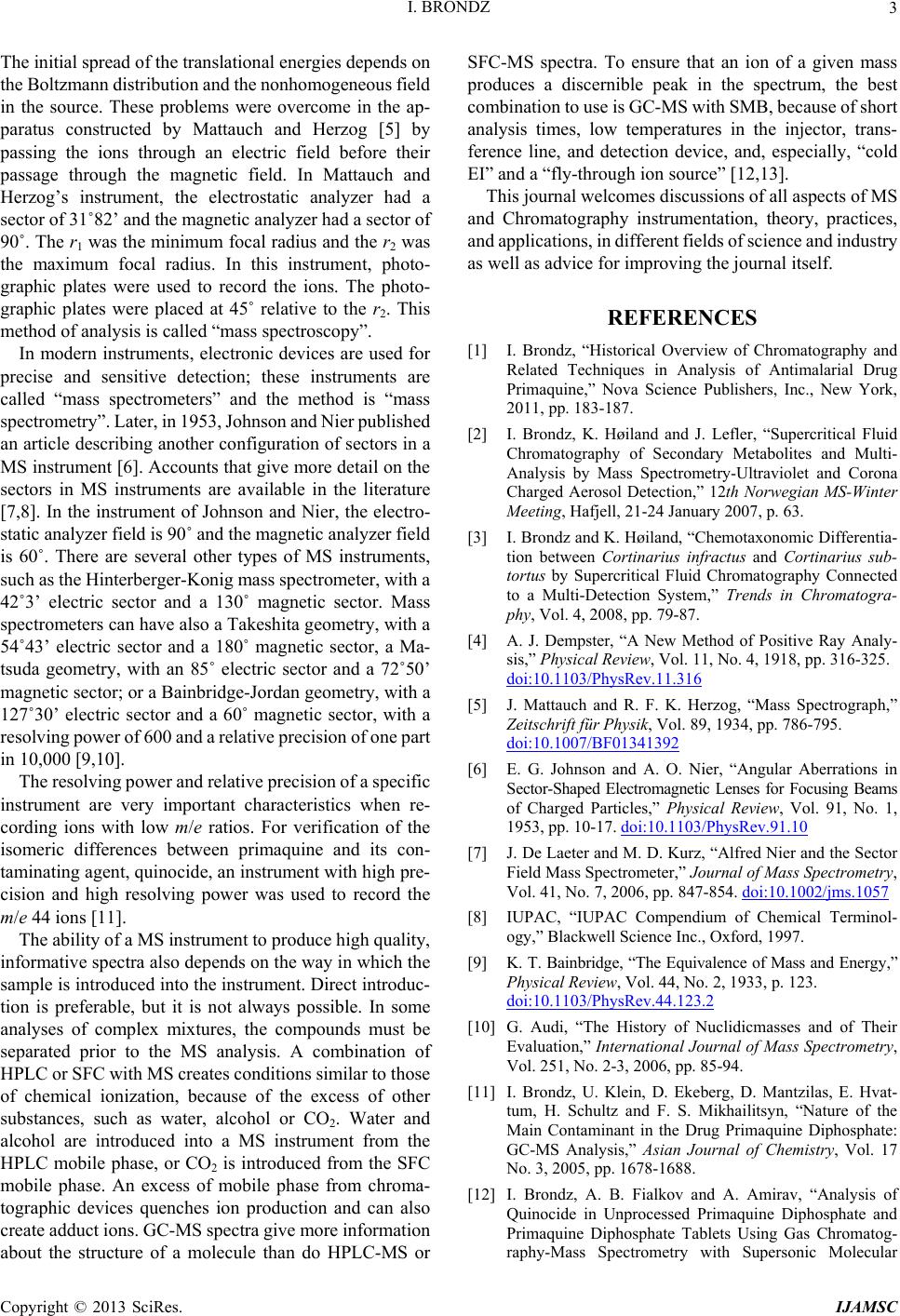
I. BRONDZ 3
The initial spread of the translation al energies depends on
the Boltzmann distribution and the nonhomogeneous field
in the source. These problems were overcome in the ap-
paratus constructed by Mattauch and Herzog [5] by
passing the ions through an electric field before their
passage through the magnetic field. In Mattauch and
Herzog’s instrument, the electrostatic analyzer had a
sector of 31˚82’ and the magnetic analyzer had a sector of
90˚. The r1 was the minimum focal radius and the r2 was
the maximum focal radius. In this instrument, photo-
graphic plates were used to record the ions. The photo-
graphic plates were placed at 45˚ relative to the r2. This
method of analysis is called “mass spectroscopy”.
In modern instruments, electronic devices are used for
pr
ower and rela tive pre cision of a sp eci
in
MS instrument to produce high qu
in
spects of M S
an
REFERENCES
[1] I. Brondz, “Hromatography and
nd and J. Lefler, “Supercritical Fluid
Differentia-
hod of Positive Ray Analy-
ecise and sensitive detection; these instruments are
called “mass spectrometers” and the method is “mass
spectrometry”. Later, in 1953, Johnson and Nier published
an article describing another configuration of sectors in a
MS instrument [6]. Accounts that give more detail on the
sectors in MS instruments are available in the literature
[7,8]. In the instrument of Johnson and Nier, the electro-
static analyzer field is 90˚ and the magnetic analyzer field
is 60˚. There are several other types of MS instruments,
such as the Hinterberger-Konig mass spectrometer, with a
42˚3’ electric sector and a 130˚ magnetic sector. Mass
spectrometers can have also a Takeshita geometry, with a
54˚43’ electric sector and a 180˚ magnetic sector, a Ma-
tsuda geometry, with an 85˚ electric sector and a 72˚50’
magnetic sector; or a Bainbridge-Jordan geometry, with a
127˚30’ electric sector and a 60˚ magnetic sector, with a
resolving power of 600 and a relative precision of one part
in 10,000 [9,10].
The reso lving pfic
strument are very important characteristics when re-
cording ions with low m/e ratios. For verification of the
isomeric differences between primaquine and its con-
taminating agen t, quinocide, an instru ment with high pre-
cision and high resolving power was used to record the
m/e 44 ions [11].
The ability of a ality,
formative spectra also depends on the way in which th e
sample is introduced into the instrument. Direct introd uc-
tion is preferable, but it is not always possible. In some
analyses of complex mixtures, the compounds must be
separated prior to the MS analysis. A combination of
HPLC or SFC with MS creates conditions similar to those
of chemical ionization, because of the excess of other
substances, such as water, alcohol or CO2. Water and
alcohol are introduced into a MS instrument from the
HPLC mobile phase, or CO2 is introduced from the SFC
mobile phase. An excess of mobile phase from chroma-
tographic devices quenches ion production and can also
create adduct ions. GC-MS spectra giv e m ore i nfor m ation
about the structure of a molecule than do HPLC-MS or
SFC-MS spectra. To ensure that an ion of a given mass
produces a discernible peak in the spectrum, the best
combination to use is GC-MS with SMB, because of short
analysis times, low temperatures in the injector, trans-
ference line, and detection device, and, especially, “cold
EI” and a “fly-through ion source” [12,13].
This journal welcom es di scussions of al l a
d Chromatography instrumentation, theory, practices,
and appl ications, in di fferent fiel ds of science and i ndustry
as well as advice for improving the journal itself.
istorical Overview of Ch
Related Techniques in Analysis of Antimalarial Drug
Primaquine,” Nova Science Publishers, Inc., New York,
2011, pp. 183-187.
[2] I. Brondz, K. Høila
Chromatography of Secondary Metabolites and Multi-
Analysis by Mass Spectrometry-Ultraviolet and Corona
Charged Aerosol Detection,” 12th Norwegian MS-Winter
Meeting, Hafjell, 21-24 January 2007, p. 63.
[3] I. Brondz and K. Høiland, “Chemotaxonomic
tion between Cortinarius infractus and Cortinarius sub-
tortus by Supercritical Fluid Chromatography Connected
to a Multi-Detection System,” Trends in Chromatogra-
phy, Vol. 4, 2008, pp. 79-87.
[4] A. J. Dempster, “A New Met
sis,” Physical Review, Vol. 11, No. 4, 1918, pp. 316-325.
doi:10.1103/PhysRev.11.316
[5] J. Mattauch and R. F. K. Herzog, “Mass Spectrograph,”
Zeitschrift für Physik, Vol. 89, 1934, pp. 786-795.
doi:10.1007/BF01341392
[6] E. G. Johnson and A. O. Nier, “Angular Aberrations in
Sector-Shaped Electromagnetic Lenses for Focusing Beams
of Charged Particles,” Physical Review, Vol. 91, No. 1,
1953, pp. 10-17. doi:10.1103/PhysRev.91.10
[7] J. De Laeter and M. D. Kurz, “Alfred Nier and the Sector
Field Mass Spectrometer,” Journal of Mass Spectrometry,
Vol. 41, No. 7, 2006, pp. 847-854. doi:10.1002/jms.1057
[8] IUPAC, “IUPAC Compendium of Chemical Terminol-
d Energy,”
ogy,” Blackwell Science Inc., Oxford, 1997.
[9] K. T. Bainbridge, “The Equivale nce of Mass an
Physical Review, Vol. 44, No. 2, 1933, p. 123.
doi:10.1103/PhysRev.44.123.2
[10] G. Audi, “The History of Nuclidicmasses and of Their
. Mantzilas, E. Hvat-
A. Amirav, “Analysis of
raphy-Mass Spectrometry with Supersonic Molecular
Evaluation,” International Journal of Mass Spectrometry,
Vol. 251, No. 2-3, 2006, pp. 85-94.
[11] I. Brondz, U. Klein, D. Ekeberg, D
tum, H. Schultz and F. S. Mikhailitsyn, “Nature of the
Main Contaminant in the Drug Primaquine Diphosphate:
GC-MS Analysis,” Asian Journal of Chemistry, Vol. 17
No. 3, 2005, pp. 1678-1688.
[12] I. Brondz, A. B. Fialkov and
Quinocide in Unprocessed Primaquine Diphosphate and
Primaquine Diphosphate Tablets Using Gas Chromatog-
Copyright © 2013 SciRes. IJAMSC